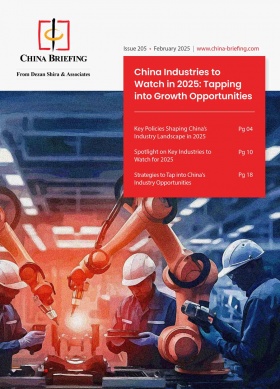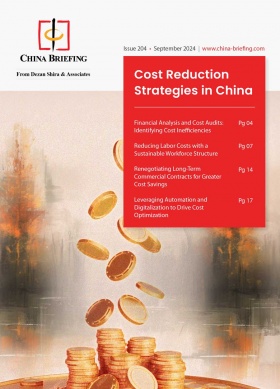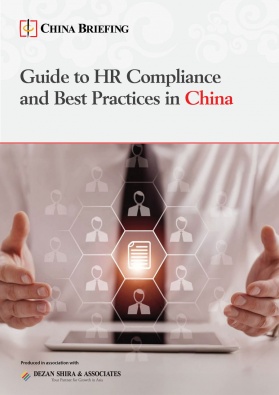Exploring the Rise of Women in China’s Workforce: Statistics and Progress in Gender Equality
China’s progress toward gender equality is shifting from a compliance-driven approach to one that is value-driven. Foreign invested enterprises must integrate gender inclusion into their long-term strategies while deepening their engagement in the local market. This is not only a demonstration of corporate social responsibility but also a key to harnessing talent dividends and boosting competitiveness.
As China continues its dynamic economic expansion, the steady rise of women in the workforce has become one of the country’s standout success stories. Drawing on the latest official data from the implementation of the China Women’s Development Outline (2021–2030)—a comprehensive report released in January 2025—this article examines the significant progress made in gender equality across various dimensions of China’s labor market, as well as fair policies and best practices of female employee management in China.
Female employee in China’s labor market
A broad base of participation
One of the most striking aspects of China’s labor market is the robust participation of women. In 2023, women accounted for 320 million of the nation’s workforce, representing 43.3 percent of total employment—a slight but steady increase from previous years. In urban non-private sectors, female employment reached 67.0 million, comprising 41.0 percent of that workforce.
This level of participation not only reflects government policies aimed at promoting employment for women but also underlines the depth of the talent pool available to enterprises. For foreign investors, this means an ever-growing base of skilled professionals capable of driving innovation and productivity.
Enhancing labor safety and health
Worker protection has been a critical focus area. Several measures have been implemented to ensure that female employees are provided with a safe and supportive working environment:
- Special protection measures: The adoption of the Special Labor Protection System for Female Employees has seen a marked improvement, with 73.5 percent of enterprises now executing these regulations—a rise of 0.6 percentage points from 2022.
- Health literacy: Female workers have demonstrated higher levels of occupational health literacy compared to their male counterparts, a testament to ongoing efforts under the Healthy China Action (2019–2030).
This enhanced focus on safety and health is essential for maintaining a motivated and productive workforce. Companies that continue to uphold these standards can expect not only to comply with local regulations but also to benefit from lower employee turnover and enhanced corporate reputation.
Breaking the glass ceiling: Women in leadership
The data reveals encouraging trends regarding female participation in decision-making and corporate governance. Women hold 37.7 percent of board positions and 41.9 percent of supervisory roles within enterprises, while making up 31.2 percent of employee representatives. These improvements, although incremental, signal a gradual dismantling of traditional barriers.
By expanding opportunities for women in leadership roles, enterprises are likely to see more diversified perspectives in strategic planning and innovation. For foreign-invested enterprises (FIEs), embracing these trends by developing internal policies that foster gender diversity can lead to more balanced decision-making and, ultimately, stronger business performance.
Women and social security
The advancements in gender equality extend well into the realm of social security, ensuring that female workers are not left behind in critical areas such as healthcare and pensions:
- Medical insurance: As of the end of 2023, 650 million women participated in basic medical insurance, with significant increases noted in both the employee and urban–rural schemes.
- Pension coverage: Women’s enrollment in basic pension insurance has expanded to 520 million—a reflection of ongoing reforms aimed at broadening coverage and ensuring long-term economic security.
- Other social insurances: Female participation in maternity, unemployment, and work injury insurance continues to grow, ensuring comprehensive support across the lifespan.
These improvements not only bolster the welfare of millions of women but also stabilize consumer markets and contribute to long-term economic resilience—a positive signal for investors seeking sustainable growth.
Challenges and best practices: How should you manage your female employee?
China boasts the largest number of female professionals globally, with female employment rates consistently exceeding the world average. However, significant challenges remain. For example, the phenomenon of “equal work, unequal pay” is still widespread, and women still encounter mid-management bottlenecks and a “glass ceiling” in top executive roles.
Companies frequently perform a cost-benefit analysis when hiring women, particularly considering the additional expenses and potential economic losses associated with pregnancy and childbirth. McKinsey Global research has found that companies in the top quartile for gender-diverse leadership teams are generally more competitive—showing a 25 percent higher probability of achieving above-average profitability compared to those in the bottom quartile.
With growing attention from top talent on gender diversity and an increased emphasis on workplace gender equality in ESG (Environmental, Social, and Corporate Governance) ratings, creating a gender-equal environment has become a critical strategy. It is not only a driver of commercial value but also a key factor in winning the talent war and enhancing a company’s ESG reputation.
Therefore, we recommend that companies view supporting female professionals as an “investment” rather than an “expense.” By adopting effective strategies to continuously optimize the management of female employees and improve workplace gender equality, organizations can ensure that female employees are treated with the respect they deserve.
Non-discrimination in recruitment
Despite the widespread condemnation of sexism, it is not rare to observe gender discrimination existing in the recruitment process in China. According to statistics provided by Zhaopin.com, one of the most popular job sites in China, 29.6 percent of women surveyed experienced some sort of gender discrimination in their job-seeking processes.
Companies must take concrete measures to reduce gender bias in hiring, or else they may not only suffer the loss of talent but are also at a higher risk of being challenged by labor authorities.
The Law of the People’s Republic of China on the Protection of Rights and Interests of Women (the Women’s Protection Law) stipulates that companies cannot refuse to employ women by reason of sex or raise the employment expectations for women, except for special types of work or advertise that the post is unsuitable for women.
The Notice on Further Regulating Recruitment Activities and Promoting Equal Employment for Women further clarifies that the below gender discrimination behaviors are prohibited in the recruitment process:
- Restricting certain gender (except for the job scopes prohibited to be assigned to female employees) or giving priority to certain gender in the recruitment announcement;
- Refusing to employ women candidates on the grounds of gender;
- Inquiring female job seekers about their marriage and childbirth status;
- Listing pregnancy test as one of the items for physical examination of new employees;
- Imposing restrictions on childbirth as a condition of employment; and
- Increase the recruitment standards for women candidates in a differentiated manner.
Employers that release recruitment information containing contents of gender discrimination will be ordered to make rectifications in accordance with the law and will be subject to fines ranging from RMB 10,000 to RMB 50,000 if failing to rectify the improper behavior.
Also, the administrative punishment imposed on any employer due to the release of recruitment information containing contents of gender discrimination will be included in the human resources market integrity record, the name and shame list of enterprises managed by the Ministry of Human Resources and Social Security (MOHRSS).
Equal pay for equal work
Equal pay for equal work is one of the most important principles in human resources management as remuneration is a key factor affecting motivation and relationships at work.
According to the 2024 China Women’s Workplace Status Survey Report released by Zhilian, in 2023, the average monthly salary for working women was RMB 8,958, a 3.1 percent increase from the previous year. This is RMB 1,331 less than the RMB 10,289 earned by men, resulting in a gender pay gap of 12.9 percent, which is roughly in line with the previous two years. This, however, doesn’t justify existing unequal practices. Companies are suggested to make additional efforts to reward the workforce fairly.
Paying your female employees at par with the position standards will send a clear and positive message about your business and corporate brand. This practice will also increase productivity by attracting the best employees and reducing turnover. Moreover, it can boost company reputation, prevent damaged employee relations, and avoid low staff morale.
Gender equality on performance review and promotion
Article 25 of the Women’s Protection Law stipulates that women and men should be treated equitably in such aspects as promotion, evaluation, and determination of professional and technological titles, and discrimination against women shall not be allowed.
In practice, however, companies may take more steps to ensure the principle of equality in hiring than in the performance review process, as the former has comparatively more concrete standards to evaluate and follow.
Given this, we suggest companies provide corresponding training to their senior management to level the playground for men and women in the workplace, which will both reduce talent turnover and increase efficiency, as well as improve the public image of the business.
Special protection to female employees
Gender equality does not mean that males and females must always be identical and require the same treatment. Given the existence of biological sex differences, it is reasonable for males and females to have different legal rights in some instances and for female employees to get special protections, especially in the biologically vulnerable periods, including menstrual period, pregnancy, and the breast-feeding period (one year counted from the date of childbirth).
Under Chinese law, female employees are granted special protections in the below three aspects:
Work arrangement
The Special Provisions on Labor Protection for Female Employees set out detailed rules on work arrangements for female employees.
First of all, female employees cannot be arranged to take positions that fall under the scope of incompatible labor work for female employees, as shown in the table below.
| Scope of Incompatible Labor Work for Female Employees |
| The scope of incompatible labor work for female employees:
(1) Underground mining operations; (2) Grade 4 physical labor-intensive work stipulated in the Physical Labor Intensive Work Grading Standards; and (3) Work involving carrying weights that exceed 20 kg six times or more per hour, or intermittently carrying weights that exceed 25 kg. |
| The scope of incompatible labor work for female employees during the menstruation period:
(1) Working under Grade 2, Grade 3, and Grade 4 cold water stipulated in the Cold Water Grading Standards; (2) Working under Grade 2, Grade 3, and Grade 4 low temperature stipulated in the Low-Temperature Grading Standards; (3) Grade 3 and Grade 4 physical labor-intensive work stipulated in the Physical Labor Intensive Work Grading Standards; and (4) Working at Grade 3 and Grade 4 high altitude stipulated in the High Altitude Work Grading Standards. |
| The scope of incompatible labor work for female employees during pregnancy:
(1) Working at premises where the density of toxic substances such as lead and lead compounds, mercury and mercury compounds, benzene, cadmium, beryllium, arsenic, cyanide, nitrogen oxides, carbon monoxide, carbon disulfide, chlorine, caprolactam, chloroprene, vinyl chloride, ethylene oxide, aniline and formaldehyde in the air at the work premises exceeds the occupational health standards of the State; (2) Working in manufacturing of the anticancer drug, diethylstilbestrol, work which has exposure to anesthetic gases, etc.; (3) Operation of unsealed sources of radioactive material, dealing with emergencies of nuclear accidents and radiation accidents; (4) High altitude work stipulated in High Altitude Work Grading Standards; (5) Working under cold water stipulated in the Cold Water Grading Standards; (6) Working under low temperature stipulated in the Low-Temperature Grading Standards; (7) Working under Grade 3 and Grade 4 high temperature stipulated in the High-Temperature Grading Standards; (8) Working with Grade 3 and Grade 4 noise levels stipulated in the Noise Level Grading Standards; (9) Grade 3 and Grade 4 physical labor-intensive work stipulated in the Physical Labor Intensive Work Grading Standards; and (10) Working in a confined space, high-pressure chamber, or diving operation, working with strong vibrations or work which requires frequent stooping, climbing, and squatting. |
| The scope of incompatible labor work for female employees during the breast-feeding period:
(1) Item (1), item (3) or item (9) in the scope of incompatible labor work for female employees during pregnancy; (2) The density of toxic substances such as manganese, fluorine, bromine, methanol, organic phosphorus compounds, and organochloride compounds in the air at the work premises exceeds the occupational health standards of the State. |
Besides, where a female employee is unable to perform her original job duties during pregnancy, the employer shall reduce her workload or arrange other suitable job duties based on the certification of the medical institution.
Moreover, for female employees who enter the seventh month of pregnancy and who are in the breast-feeding period, the employer shall not extend her working hours or assign night shift duties. For the former, employers should also allocate fixed resting time during their working hours.
Leaves
Female employees in China are granted extra leaves related to pregnancy and childcare, including prenatal check-up leave, maternity leave, breast-feeding leave, and childcare leave.
- Prenatal check-up: Starting from the 12th week of pregnancy, a pregnant employee will need to go for an increasing number of prenatal check-ups, for which she is entitled to paid leave. These check-ups will be logged in the ‘pregnancy handbook’ provided by the local Community Health Service Center. Generally, there will be around 10 prenatal check-ups during the whole pregnancy period. And the number of check-ups will be far beyond that whenever an abnormal situation is spotted. It’s not proper for the employer to limit the prenatal check-up times by any means.
- Maternity leave: Maternity leave in China includes two parts—the basic maternity leave granted by the State Council and the extra maternity leave granted by local governments (vary from province to province). Generally, the basic maternity leave is 98 days for normal childbirth, which can be extended by 15 days under special circumstances, such as dystocia and multiple births. Employees can choose to start the leave 15 days prior to the expected date of childbirth. In case of miscarriage or abortion, the female employee can be granted 15 days maternity leave for pregnancy shorter than four months, and 42 days of maternity leave for pregnancy reaching four months.
- Breast-feeding leave: When a female employee comes back to work after maternity leave, she will still be granted at least one hour of paid leave per day during work hours for breast-feeding. By law, the breastfeeding period lasts one year, which is counted from the date of childbirth. In practice, companies tend to ask employees to work a full eight-hour day and allow them to accumulate the extra hour toward vacation time.
- Childcare leave: Childcare leave is very new in China and has only been formally introduced since 2021 as part of an effort to address the growing demographic imbalance and boost childbirth. It is granted to employees who have children under a certain age. In most provinces, childcare leave is 10 days per year until their children reach three years old, but there are provinces that grant longer or shorter childcare leave, as stipulated by the local family planning regulations.
Termination
In China, it is illegal to terminate a pregnant employee during her pregnancy, maternity leave, or breastfeeding period unless the termination is requested by the female employee, mutually agreed, or due to the inappropriate behaviors specified in the Labor Contract Law that constitute lawful grounds for immediate termination.
Further, if an employee gets pregnant during the term of her fixed-term contract, and the contract ends during the pregnancy, the contract shall be automatically extended (through a renewed end date or a second contract) until the end of the breast-feeding period.
Prevent sexual harassment
Chinese law explicitly prohibits sexual harassment in the workplace, with Article 1010 of the Civil Code stipulating that the victim has the right to request the perpetrators to bear civil liability for acts of sexual harassment in the forms of verbal remarks, written language, images, physical behaviors or otherwise against the will of another person, and requires employers must take reasonable measures to prevent sexual harassment and provide proper channels of complaint.
However, it’s widely believed that the legislation and regulation pertaining to sexual harassment tend to be broad-based, preventive, and provide little detail on ‘what’ amounts to sexual harassment.
Considering the potentially tremendous and negative impact of sexual harassment cases on businesses, employers are suggested to clearly define what types of behaviors are inappropriate and establish a strict anti-harassment code and culture for their businesses, in the absence of a clear and uniform legal protocol for handling sexual harassment cases.
Specifically, employers could take the following anti-harassment measures:
- Define what types of behaviors are inappropriate, write them into the company’s employee handbook, and stipulate such behaviors will result in investigations and special punishments.
- Provide effective complaint channels for victims to report an instance of sexual harassment and develop protocols to ensure such complaints will be managed properly.
- Offer workplace education and training to prevent sexual harassment.
- Clearly communicate the anti-harassment code of the company to all employees.
Among others, regarding the complaint channels and complaint management, the below protocols can help employers minimize risks and losses should sexual harassment take place in their organizations:
- Victims should be given multiple options for reporting so that they can choose the option that they feel most comfortable with.
- Depending on the size and structure of the business, the sexual harassment case can be reported to human resources (HR), the relevant manager or supervisor, an owner or executive, or a dedicated sexual harassment complaint system. For foreign companies or small branch offices, employees should be given the option to report directly to headquarters.
- Where the sexual harassment is reported in a real-name manner or of other serious circumstances, the reporting should be regarded as a case of high severity and be reported to company headquarters, the group chief compliance officer, the chief human resources officer, or the CEO immediately.
- An independent investigation team should be set up to independently investigate the complaint, and the investigator or the company’s compliance officer shall timely reply to the victim about the progress.
- During the investigation, according to the nature of the case, the perpetrator can be temporarily suspended from work.
- Meanwhile, if loopholes or defects are found in the existing system and the process of the company in case of an investigation, the process should be updated, amended, and improved.
By timely responding to the whistleblower and conducting an independent compliance investigation, letting the whistleblower know that the company has taken their reports seriously and the disciplinary violations of the reported personnel will be seriously dealt with according to the investigation results and the company policies, the situation can be prevented from getting worse. Better, it sets clear precedents that contribute to a safer, transparent, and healthier work environment, which will attract employees used to or appreciative of such standards. Companies should aim to be industry leaders in this regard.
About Us
China Briefing is one of five regional Asia Briefing publications, supported by Dezan Shira & Associates. For a complimentary subscription to China Briefing’s content products, please click here.
Dezan Shira & Associates assists foreign investors into China and has done so since 1992 through offices in Beijing, Tianjin, Dalian, Qingdao, Shanghai, Hangzhou, Ningbo, Suzhou, Guangzhou, Haikou, Zhongshan, Shenzhen, and Hong Kong. We also have offices in Vietnam, Indonesia, Singapore, United States, Germany, Italy, India, and Dubai (UAE) and partner firms assisting foreign investors in The Philippines, Malaysia, Thailand, Bangladesh, and Australia. For assistance in China, please contact the firm at china@dezshira.com or visit our website at www.dezshira.com.
- Previous Article Unlocking Growth: China-Czech Republic Investment and Trade Opportunities
- Next Article EU-China Relations After the 2024 European Elections: A Timeline









